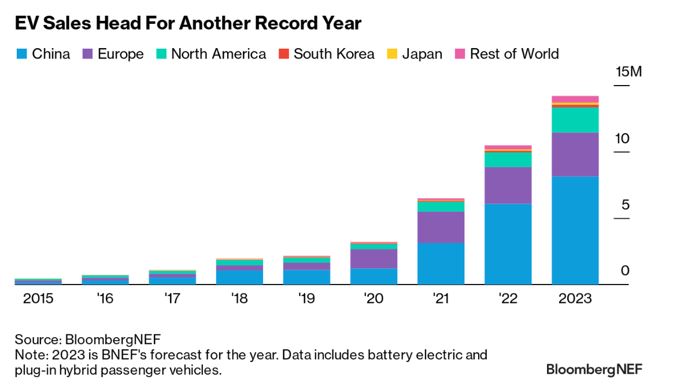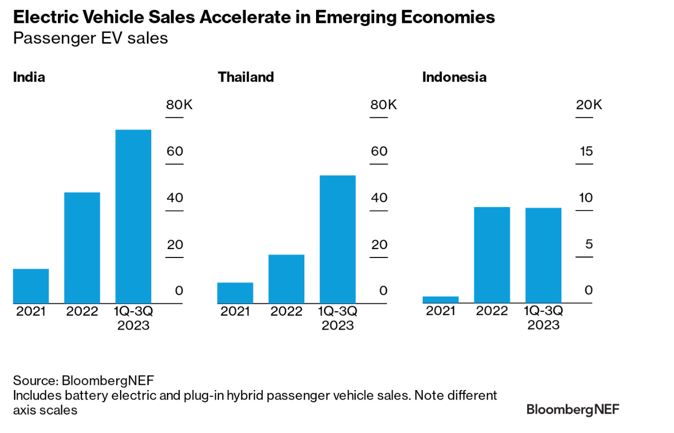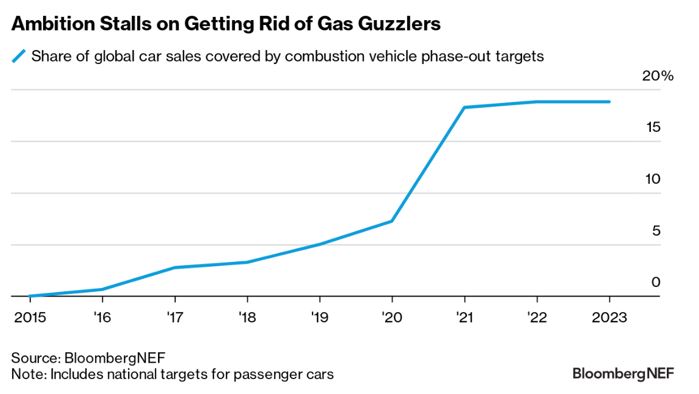By Colin McKerracher, Head of Advanced Transport, BloombergNEF
With the climate and energy world gathering in Dubai this week for COP, BloombergNEF has published its annual zero emission vehicle factbook. We first launched this report at COP26 in Glasgow to provide a comprehensive picture on where we are on the journey to cleaning up road transport globally.
Here are four interesting storylines from our latest report, which is available for download here.
No sign of an EV slowdown
For all the headlines written in the last six months about how EV demand is faltering, the data definitely doesn’t support that, or at least not yet. Sales of passenger EVs are on pace to hit 14 million this year, up 36% from 2022. In the US, where most of the concerns on demand have been raised, sales are growing even faster and will be up 50% this year. Sales might be less than some manufacturers were hoping for, but they are in line BNEF’s forecast from the beginning of the year, and most industries would be very happy with that kind of growth rate.

A slowdown could still be coming, but for now this looks much more like a winnowing down of who is competitive in the market than a general drop-off in demand. Pure-play EV automakers like Tesla, BYD and Li Auto will capture 7% of the global vehicle market this year, up from just 1% in 2020. Many legacy automakers have launched products that are not competitive on price, range or features and will have to go back to the drawing board.

More progress on ZEV adoption in emerging economies
EV adoption is rising quickly in emerging economies like India, Thailand and Indonesia, where low-cost models are driving demand. EVs are already 9% of cars sold in Thailand – a similar adoption rate to the US – which runs counter to the argument that EVs are only a rich-country phenomenon. The numbers are still modest overall, but the growth rate is encouraging in these fast-growing auto markets. With more new models in the $10,000 range hitting the market, growth should continue.

The US Inflation Reduction Act (IRA) has supercharged investments in the North American EV supply chain over the past year
BNEF data shows that IRA has attracted $100 billion of new investment announcements in EV and battery manufacturing as well as other areas like battery components and recycling. Constructions is already underway for many of these and BNEF expects the first IRA-related EV and battery manufacturing facilities to open fully in the second half of 2024, with more ramping up in 2025 and beyond. Canada and Mexico also benefit, given their integration in the US automotive supply chain and access to key critical minerals.

Ambition on phasing out combustion vehicle sales has stalled
From 2015 to 2021 the number of countries committing to ending sales of new combustion vehicles rose quickly. This received a big boost in 2021 when the EU announced its target of a 2035 phase-out, but progress has stagnated since then with only a few minor additions to the list over the last two years. Countries with phase-out targets in place now represent 19% of new passenger vehicle sales.

Full phase-outs are not the only targets that matters. Indeed, both the US and China have partial targets in place for 2030, when China is aiming for EVs to be 40% of sales and the US is aiming for 50%. The China target could be achieved as early as next year, but the US one will be more challenging. Setting targets is easier than delivering on them.
Announcements from automakers have also stalled. A total of 18 automakers of various sizes have announced net-zero commitments targeting 2050 or before. These automakers represent 54% of the global passenger vehicle market, but not all of them have clarified whether their targets will cover the vehicles they sell or just their own operations. The number of them formally committing to ending sales of new combustion vehicles is smaller and covers 32% of global sales.
No new automakers announced net-zero or combustion vehicle phase out commitments in 2023, and some like Ford and GM moved their near-term EV targets back this year citing worse-than-expected demand.

Electric vehicles remain one of the fastest moving parts of the energy transition and there are plenty of reasons for optimism, but a stronger push from both policymakers and automakers will be needed to keep up the momentum in the years ahead.
– With assistance from Aleksandra O’Donovan
The full report is available for download here.






